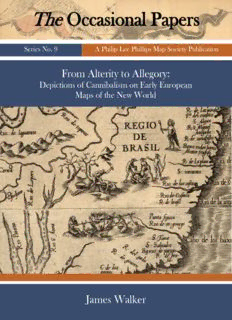
From Alterity to Allegory PDF
Preview From Alterity to Allegory
The Occasional Papers Series No. 9 A Philip Lee Phillips Map Society Publication From Alterity to Allegory: Depictions of Cannibalism on Early European Maps of the New World James Walker i The Occasional Papers A Philip Lee Phillips Map Society Publication Editorial Staff: Ralph E. Ehrenberg Managing Editor Ryan Moore Chief Editor, Design and Layout Michael Klein Editor Anthony Mullan Editor David Ducey Copy Editor Geography and Map Division Library of Congress Washington, D.C. Summer 2015 From Alterity to Allegory: Depictions of Cannibalism on Early European Maps of the New World James Walker Foreword The Philip Lee Phillips Map Society of the Library of Congress is a national support group that has been established to stimulate interest in the Geography and Map Division’s car- tographic and geographic holdings and to further develop its collections through financial dona- tions, gifts, and bequests. The Phillips Map Society publishes a journal dedicated to the study of maps and collections held in the Division known as The Occasional Papers. This install- ment focuses on images of cannibals on early European maps of the New World. I heard Dr. James Walker, the author, deliver a version of this paper while attending a conference at the Society for the History of Discoveries in Tampa, Florida in 2013. I was im- pressed with his discussion of a wide range of cartographic sources, including a number of im- portant holdings in the Geography and Map Division of the Library of Congress. He synthe- sized an array of cartographic works and thoughtfully commented on how the imagery on the borders of the early European maps of the New World presented a false impression of both the land and people that was believed to be true by many Europeans. Dr. Walker reminded the au- dience how maps, especially wall-sized maps, were considered encyclopedic sources of infor- mation. Such is the testament to the power of the printed word and more so to the power of the printed image that they can shape one’s view of the world. This fact is one of many compelling reasons that we are fascinated by maps. During that weekend, I was meeting with the Phillips Map Society Steering Committee. Thomas J. Touchton, a long-standing member and great contributor to our group’s interests, arranged for the Steering Committee to gather at SHD. It was there that Dr. Walker was sug- gested as a new Steering Committee member, as well as Robert David, the current director of the Miami International Map Fair. (A position previously held by Joseph Fitzgerald, a founding iii a nd respected member of the Steering Committee, who recently retired from the board.) Both gentleman have a great fascination for maps, and we moved to “recruit” them. Their contribu- tions, as those of all members, help our group thrive and prosper. With that thought in mind, while each one of us is on the lookout for the next compelling map to research or collect, we should also be watchful for new members who possess the desire to learn, collect, and even write about maps. These are the qualities that motivate members of the Phillips Map Society. Ralph E. Ehrenberg Chief, Geography and Map Division iv Preface My collecting and research interests in maps are derived from how early European maps of the “New World” served not only the purpose of detailing geography, but how these maps presented the point of view of their European makers. When European map readers learned of discoveries, as in newly discovered from the European perspective, they were as- similating Eurocentric political and ideological concepts associated with these lands. The earliest published texts of exploration and discovery addressed geography, the culture and customs of native peoples, and potential resources. They illustrated European imperial aspi- rations and helped to establish and reinforce stereotypes of indigenous peoples, particularly as cannibals. Eurocentric worldviews appeared in place names, such as New Spain or New France, which imparted a European right to sovereignty. Map legends identified resources that Europeans wished to acquire. Even the seemingly innocuous decorative features on maps, such as ships, ethnographic images, and cartouches, when placed near unfamiliar land- scapes, enabled mapmakers to image the New World as a place that would belong to Europe- ans; in doing so, indigenous peoples were shown as inferiors -- those “others” who were fas- cinating and yet bestial. The following article draws from the work of many scholars who have described this phenomenon. I extend my appreciation to Ralph Ehrenberg and the Philip Lee Phillips Map Society for the opportunity to prepare this article and to Ms. June Black at the University of Oregon for her assistance in procuring several of the images. James Walker, M.D. Steering Committee Phillips Map Society v Contents Foreword by Ralph E. Ehrenberg iii Preface v Essay Introduction 1 Cannibals on the Edge of Civilization 3 Man on the Spit 5 Non-European Maps and Cannibals 15 America as an Allegory and Cannibalism 17 Cannibals Fade from Maps 21 Endnotes 23 Map Figures and Illustrations 29
Description: